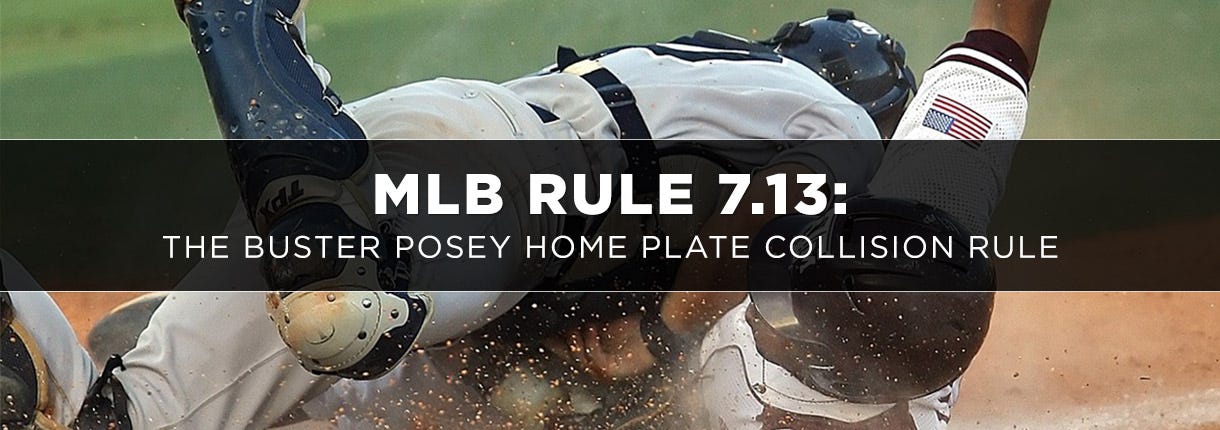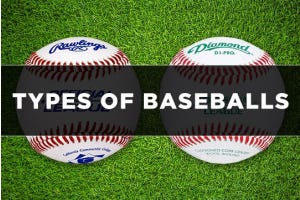The Buster Posey Rule & Home Plate Collisions: MLB Rule 7.13

Since the beginning of the sport, runners and catchers colliding at the plate have been a huge part of baseball. Bottom of the 9th, down by one, one out, and a runner on third, everyone knows what is about to happen. Batter pops it up to shallow right field, runner tags and it’s going to be close. Right fielder lasers it home and the runner and catcher collide. Everyone is on the edge of their seat. The umpire throws his hands in the air — “Safe”. Run is in and the home team forces extra innings. The “Play at the Plate” is the best play in baseball. Catcher’s equipment is essential in protecting against batted balls, wild pitches and of course collisions at the plate, so make sure you always have the proper gear on when you’re behind the dish!
While a bang-bang play at the plate is still a very exciting play in baseball, the added excitement of a possible plate collision has been almost completely removed with the help of catcher’s like Buster Posey, but not solely him. The terrible collision that Buster Posey went through shed some light on the real danger a home plate collision can bring to players. Below we will discuss everything you need to know about the Buster Posey collision, and the rule that was born because of it.
The Buster Posey Collision
On May 25, 2011, during an extra-inning game between the Giants and Marlins, Scott Cousins went hard into home plate and had a huge collision with Buster Posey, ultimately shattering Posey’s leg, and putting a huge damper on the Giants’ season. This led to many people in the baseball community to begin thinking about finding a better way to protect catcher’s and all players in general.
Timeline of Home Plate Collision Rule Change
It was not until almost three full years after the Buster Posey collision that MLB decided to implement the new rule on home plate collisions. This was after a handful of other collisions at the plate being looked over by MLB. It was not until a collision in the 2013 ALCS that included Alex Avila, that MLB began actually taking a rule change into consideration. Below is a short timeline of the events prior to the “Buster Posey Rule” or Rule 7.13 being introduced by MLB.
- May 25, 2011 – Buster Posey collision and injury
- July 30, 2011 – Matt Treanor is injured after a collision at home plate
- October 7, 2013 - Dioner Navarro exits game after home plate collision
- October 17, 2013 - Alex Avila injured in the ALCS
- February 24, 2014 - MLB introduces a new rule on home-plate collisions
MLB Rule 7.13
Rule 7.13 was introduced by MLB on February 24, 2014. It was first introduced as an experimental rule for both MLB and MiLB that would be implemented for the 2014 season. Below is a list of the main key points of the rule:
- A runner attempting to score may not deviate from his direct pathway to the plate in order to initiate contact with the catcher (or other player covering home plate).
- Unless the catcher is in possession of the ball, the catcher cannot block the pathway of the runner as he is attempting to score.
- The failure by the runner to try to touch the plate, the runner’s lowering of the shoulder, or the runner’s pushing through with his hands, elbows or arms, would support a determination that the runner deviated from the pathway in order to initiate contact with the catcher in violation of Rule 7.13.
- Notwithstanding the above, it shall not be considered a violation of this Rule 7.13 if the catcher blocks the pathway of the runner in order to field a throw, and the Umpire determines that the catcher could not have fielded the ball without blocking the pathway of the runner and that contact with the runner was unavoidable.
Does the Home Plate Collision Rule Improve the Game?
While the key goal of Rule 7.13 is to make the game safer for players, which is thought of as great by most people around the game, there is still a good deal of controversy surrounding the whole thing. Below we have put together a list of pros and cons based around ideas we have heard around the community regarding the introduction and implementation of this rule.
Pros
- Protects catchers from concussions and other injuries such as injuries to the legs, arms or back
- Also protects baserunners from injury suffered by colliding with a catcher in full protective gear
- Prevents potential season or career ending injuries for all players
- Can save a team’s season by preventing a long term injury to all players, including franchise players
Cons
- Bang-bang plays at the plate are extremely exciting; this rule somewhat puts a damper on this excitement as players have to be more careful with how they execute the play
- It is sometimes tough to dictate whether or not the rule was followed properly on a play at the plate, and can lead to lots of down time as umpires try to figure out the correct call
Should Home Plate Collision Rules Be Changed?
Whether you are in favor of the “Buster Posey Rule” or Rule 7.13 being implemented or not, you can’t ignore that there are valid reasons for both sides of the argument. How do you feel? Do you agree with the rule being changed or do you believe collisions at the plate should be allowed?
Plate collisions or not, it is always important to make sure you have the proper gear if you play behind the dish. You can shop catcher’s gear on our website, or stop by one of our MonkeySports Superstore locations for in-person expert advice!








